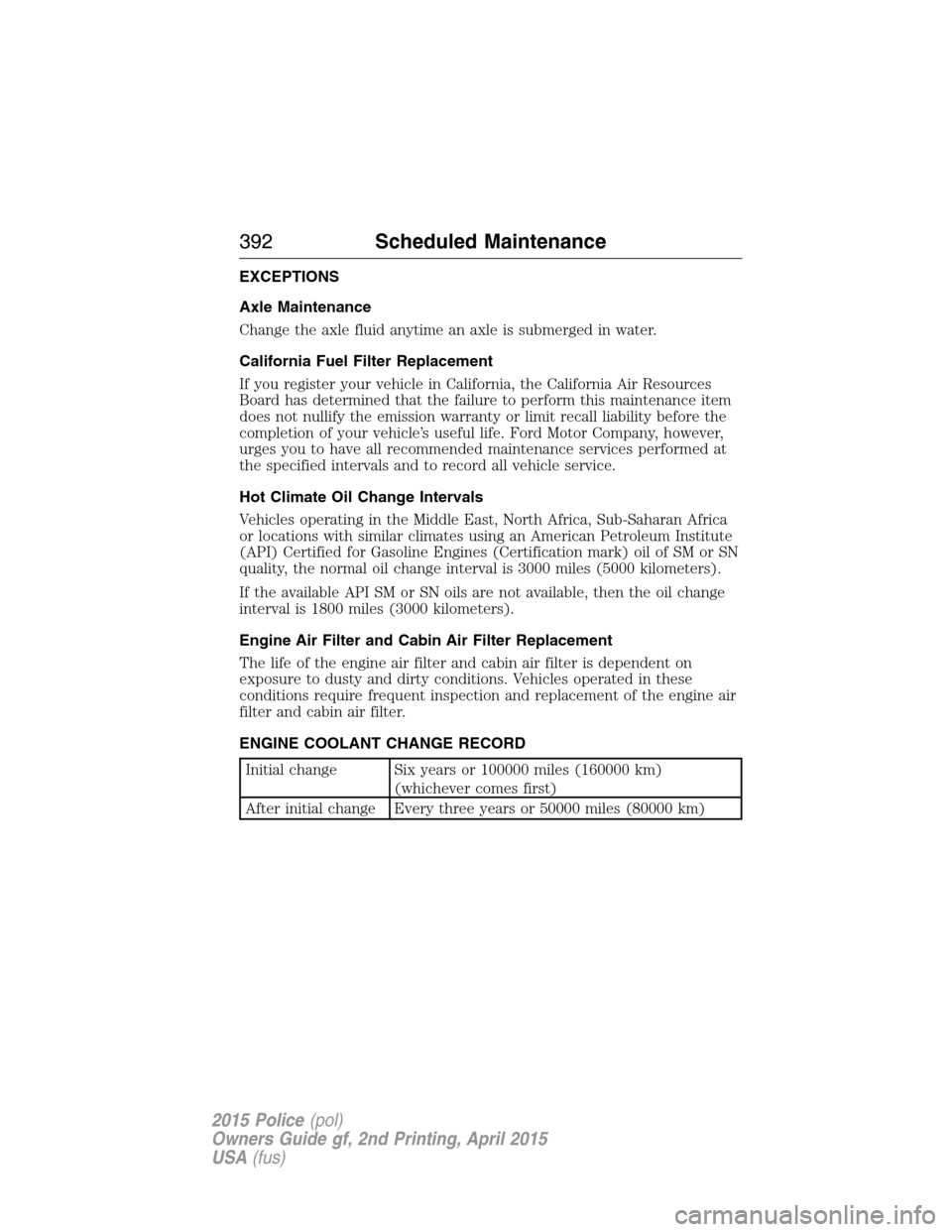Page 390 of 401
To assist fleet managers in maintaining proper oil change intervals, the
idle meter helps determine when an oil change is required. For every
hour that the vehicle idles, it has accumulated the equivalent of
approximately 33 miles (53 kilometers) of driving. Using the combination
of the vehicle odometer and idle meter allows the fleet manager to better
determine when the oil needs to be changed.
Engine idle hour meter calculation:
Idle hours x 33 = miles (kilometers) equivalency
Miles (kilometers) driven + miles (kilometers) equivalency = oil change
interval
Example:When the odometer has accumulated 3000 miles
(4800 kilometers) and the idle meter shows 61 hours, a 5000 mile (8000
kilometer) oil change interval has been reached: 3000 road miles (4800
road kilometers) + (61 idle hours x 33 miles [53 km]/idle hour) =
5013 miles (8067 kilometers).
Scheduled Maintenance389
2015 Police(pol)
Owners Guide gf, 2nd Printing, April 2015
USA(fus)
Page 393 of 401

EXCEPTIONS
Axle Maintenance
Change the axle fluid anytime an axle is submerged in water.
California Fuel Filter Replacement
If you register your vehicle in California, the California Air Resources
Board has determined that the failure to perform this maintenance item
does not nullify the emission warranty or limit recall liability before the
completion of your vehicle’s useful life. Ford Motor Company, however,
urges you to have all recommended maintenance services performed at
the specified intervals and to record all vehicle service.
Hot Climate Oil Change Intervals
Vehicles operating in the Middle East, North Africa, Sub-Saharan Africa
or locations with similar climates using an American Petroleum Institute
(API) Certified for Gasoline Engines (Certification mark) oil of SM or SN
quality, the normal oil change interval is 3000 miles (5000 kilometers).
If the available API SM or SN oils are not available, then the oil change
interval is 1800 miles (3000 kilometers).
Engine Air Filter and Cabin Air Filter Replacement
The life of the engine air filter and cabin air filter is dependent on
exposure to dusty and dirty conditions. Vehicles operated in these
conditions require frequent inspection and replacement of the engine air
filter and cabin air filter.
ENGINE COOLANT CHANGE RECORD
Initial change Six years or 100000 miles (160000 km)
(whichever comes first)
After initial change Every three years or 50000 miles (80000 km)
392Scheduled Maintenance
2015 Police(pol)
Owners Guide gf, 2nd Printing, April 2015
USA(fus)
Page 396 of 401

C
Capacities for refilling fluids ....296
Cargo management system ......165
CD ..............................................310
CD player ..................................308
Cell phone use ............................16
Changing a tire .........................284
Child safety restraints ..........28, 31
Child safety seats
attaching with tether straps ....31
automatic locking mode
(retractor) .................................38
LATCH .......................................28
Child safety seats - booster
seats .............................................22
Cleaning your vehicle ...............248
engine compartment ..............250
instrument panel ....................252
interior .....................................252
plastic parts ............................250
washing ....................................248
waxing .....................................250
wheels ......................................254
wiper blades ............................251
Climate control (see Air
conditioning or Heating) ..........107
Clock ..........................................310
Console ......................................118
overhead ..................................119
Coolant ......................................218
checking and adding ..............218
refill capacities ........................296
specifications ..........................296
Cross Traffic Alert ....................158
Cruise control ...........................156
Customer Assistance ................186Ford Extended Service
Plan ..........................................305
Getting roadside assistance ...186
Getting the service you
need .........................................192
Ordering additional owner’s
literature .................................198
Utilizing the
Mediation/Arbitration
Program ...................................196
D
Defrost .......................................107
rear window ............................108
Dipstick
automatic transmission
fluid ..................................224, 227
engine oil .................................217
Driving under special
conditions ..................138, 142, 144
sand .........................................143
snow and ice ...........................145
through water .................144, 184
E
Electronic message center .........98
Electronic stability control ......151
Emergencies, roadside
jump-starting ..........................188
running out of fuel .................128
Emergency brake
(see Parking brake) ..................148
Emission control system ..........133
End user license agreement ....366
Engine ........................................294
cleaning ...................................250
coolant .....................................218
fail-safe cooling .......................222
Index395
2015 Police(pol)
Owners Guide gf, 2nd Printing, April 2015
USA(fus)
Page 397 of 401

idle speed control ...................229
lubrication specifications .......296
refill capacities ........................296
service points ..................213, 215
Engine block heater .................124
Engine oil
checking and adding ..............217
dipstick ....................................217
filter, specifications ................302
refill capacities ........................296
specifications ..........................296
Event data recording ..................11
Exhaust fumes ..........................124
F
Fail safe cooling ........................222
Floor mats .................................185
Fluid capacities .........................296
Four-Wheel Drive vehicles
driving off road .......................141
Fuel
cap ...........................................130
capacity ...................................296
choosing the right fuel ...........127
filler funnel .............................128
filling your vehicle with fuel ..130
filter, specifications ........228, 302
fuel pump shut-off ..................188
octane rating ...........................128
quality ......................................127
running out of fuel .................128
safety information relating to
automotive fuels .....................126
Fuel and distance computer ....100
outside temperature
indicator ..................................100
to empty indicator ..................100
trip distance ............................100trip/reset button .....................100
Fuses ..........................................200
G
Gas cap (see Fuel cap) ............130
Gauges .........................................92
odometer .................................100
trip odometer ..........................100
H
Hazard flashers .........................188
Headlamps
aiming ......................................235
bulb specifications ..................245
flash to pass ..............................82
high beam .................................81
replacing bulbs .......................237
Head restraints .........................111
Heating ......................................107
Hood ..........................................211
I
Ignition .......................................121
Illuminated visor mirror .............91
Information displays ...................98
Inspection/maintenance (I/M)
testing ........................................136
Instrument panel
cleaning ...................................252
cluster ........................................93
J
Jack ............................................284
positioning ...............................284
storage .....................................284
396Index
2015 Police(pol)
Owners Guide gf, 2nd Printing, April 2015
USA(fus)